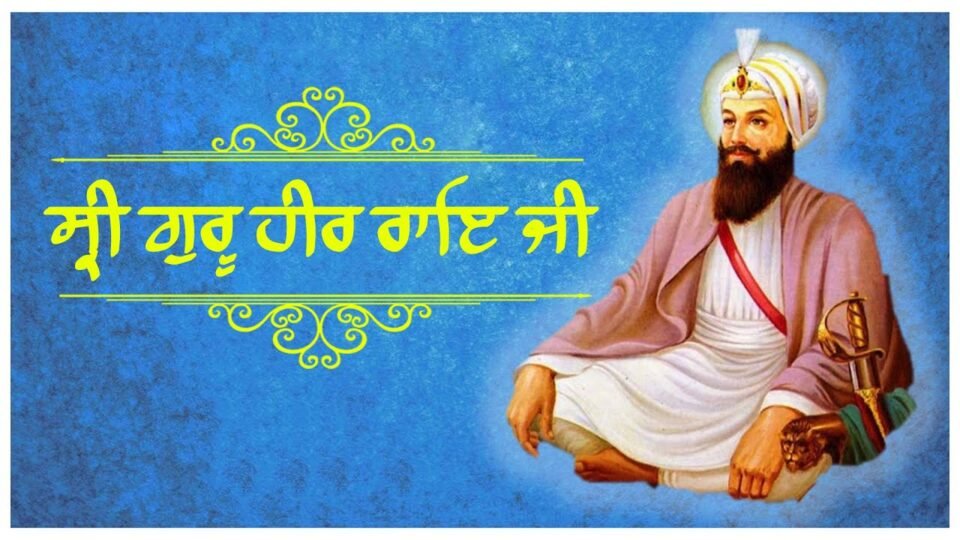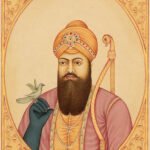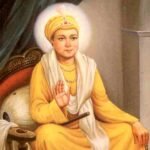Sri Guru Har Rai Ji
Sri Guru Har Rai Sahib Ji – 7th Sikh Guru Devoted himself to further spreading the teachings of Guru Nanak, and excommunicated his son Ram Rai from Sikhi for manipulating a word of Gurbani in front of Aurangzeb.
| Name of Guru | Sat Guru Har Rai Sahib Ji, Sodh Vansh. |
|---|---|
| Birthplace | Kiratpur Sahib Ji |
| Birthday | 1687 Bikrami Magh Sudi 14th, Sunday, 28th January 1630 CE, Nakshatra Bharni (Another Version – 16 January 1630) |
| Parents | Mata Nihal Kaur Ji from Batala, Nana Rama Ji, Nani Sukhdeyi Ji. Father Baba Gurditta Ji – Son of Satguru Hargobind Sahib Ji. |
| Spouse | Mata Krishan Kaur Ji or Kishan Kaur aka Sulakhni Ji, Chand Kaur Ji, Ram Kaur Ji, Kot Kalyani Ji, Tokhi Ji, Anokhi Ji, Lado Ji, Prem Kaur Ji. According to Bhai Mani Singh’s Gur Bilas – Daya Ram of Anoop Shahar (Bulandshahar) near Garh Ganga came to Satguru Hargobind Sahib Ji for Darshan with the entire family and getting acceptance by Satguru, all his 8 Daughters were married to Har Rai Ji. Marriage at Arupnagar (Distt Gujranwala) On Harh Sudi 3, Samvat 1697 accordingly 22nd June 1640. (*Another Date 16 May 1640) |
| Gurgaddi | 1700 Bikrami Chet Vadi 13th, Kiratpur Sahib, 17th April, 1643 CE (*HS Dilgeer Date – 27th Feb 1641) (SGPC Date – 3rd March 1644 ) |
| Joti Jot | 1718 Bikrami Kattak Vadi 9th, November 16th, 1661 CE, Patalpuri, Kiratpuur Sahib. (SGPC, HS Dilgeet Version 06.10.1661) |
| Children | Baba Ram Rai Ji from Mata Ram Kaur Ji, Sri Guru Harkrishan Sahib Ji from Mata Krishan Kaur Ji. |
| Total Age | 31 Years |
| Guruship Period | 17 Years |
| Throned King | Shahjahan, Aurangzeb |
Short Biography of Guru Har Rai Ji
Guru Har Rai was the seventh Guru of the Sikhs, who lived from 1630 to 1661 and served as the leader of the Sikh community from 1644 until his death. He was born in Kiratpur Sahib, a town in present-day Punjab, India, and was the grandson of the sixth Sikh Guru, Guru Hargobind.
Guru Har Rai was a man of peace and was known for his kindness and compassion towards all beings. He was deeply committed to the Sikh principles of equality, justice, and selfless service. During his time as Guru, he worked tirelessly to promote these values and to improve the lives of his followers.
One of the most significant events during Guru Har Rai’s tenure as Guru was the alteration of a line of Guru Nanak’s hymn by his elder son, Ram Rai, in order to please the Mughal Emperor. This act was considered a grave insult to Guru Nanak’s teachings, and as a result, Guru Har Rai disowned Ram Rai and declared that he was not fit to be his successor.
Instead, Guru Har Rai chose his younger son, Har Krishan, as his successor, even though he was only five years old at the time. Guru Har Rai instilled in his followers the importance of following Har Krishan as his image and putting faith in him, as he believed that this was the only way to obtain salvation.
Guru Har Rai was also known for his love of nature and his commitment to preserving the environment. He was a skilled healer and used herbal remedies to treat his followers’ ailments. He established a garden in Kiratpur Sahib, which was a center for the study of botany and herbal medicine.
Guru Har Rai Ji Ascended to Sachkhand on November 15th, 1661, at the age of 31. His legacy lives on through the Sikh community, who continue to follow his teachings of compassion, equality, and selfless service.
Life and Legacy of Guru Har Rai Ji
Guru Har Gobind, the sixth Sikh Guru, had five sons and one daughter, among whom the eldest was Baba Gurditta. Baba Gurditta had two sons, Dhir Mal, and Har Rai. Unfortunately, Dhir Mal turned out to be disloyal and disobedient. He took possession of Guru Har Gobind’s property and the original copy of the Adi Granth, thinking that he would be regarded as the religious leader of the Sikhs. But his selfish actions were to no avail.
Before passing away, Guru Har Gobind nominated Har Rai, Dhir Mal’s younger brother, as his successor. From a young age, Har Rai had a tender heart and was deeply affected by the sight of the flowers he had accidentally damaged while passing through a garden as a child. He made a vow never to harm anything in the world and always walked with his skirts tucked up. As he grew older, he carried the same spirit with him and often quoted Baba Farid’s words, “All men’s hearts are jewels; to distress them is not at all good; If thou desire the Beloved, distress no one’s heart.”
Guru Har Rai was known for his magnanimity and simplicity. He did not desire lavish food and instead used whatever valuable offerings were made to him to feed his guests. He also followed his grandfather’s advice and kept twenty-two hundred mounted soldiers. In the afternoons, he would go for a chase, but he never forgot his commitment to protecting animals. He would take the animals he caught during the chase, free them, and protect them in a zoological garden that he had created for his followers’ recreation.
Love and compassion personified
Guru Har Rai’s life was full of compassion, love, and generosity. His teachings continue to inspire us to be kind to all living beings and to work towards a world free from selfishness and harm.
As the sun set each day, the Guru would gather his court, and the air would fill with the sweet melody of hymns sung by his choir. As his followers listened with rapt attention, the Guru would impart divine wisdom, guiding them on their spiritual journey.
In the court of the great Emperor Shah Jahan, a dark cloud hung over the royal family. The heir-apparent, Dara Shikoh, lay gravely ill, and despite the best efforts of physicians and astrologers, he showed no signs of recovery. The Emperor was at his wit’s end until wise men advised him that only a rare combination of herbs could save his beloved son. Yet, these herbs could not be found anywhere in the empire.
Desperate, the Emperor had no choice but to turn to the Guru, whom he had previously misunderstood and misjudged. With a humble heart, the Emperor wrote a letter to the Guru, invoking the history of his dynasty’s relationship with the Gurus, and pleading for his son’s life. The Guru, ever magnanimous, did not hesitate to offer his help.
He sent the required medicine, along with his prayers, and Dara Shikoh was cured. The Emperor, overjoyed and grateful, realized the error of his ways and vowed to never again cause any harm or annoyance to the Guru. The Guru, wise and compassionate, chose to return good for evil, and his act of kindness left a lasting impact on the Emperor’s heart.
Once, while on a horseback ride, the Guru came upon the humble abode of a poor woman. Knocking on her door, he kindly requested for some bread to quell his hunger. Overjoyed to have the opportunity to serve the great Guru, the woman eagerly offered him some coarse bread, which he accepted without hesitation. Without even washing his hands, the Guru enjoyed the bread and blessed the woman, freeing her from the chains of transmigration.
The following day, the Sikhs prepared a lavish feast for their beloved Guru, with great attention to cleanliness and ancient ceremonial practices. However, the Guru merely chuckled at their efforts and declined the food. Perplexed, the Sikhs inquired as to why their offering was rejected, given that it was meticulously prepared and free from impurities. The Guru patiently explained, “The woman who fed me yesterday did so with great devotion and faith, using her hard-earned bread to serve me. Her selfless act made the food pure, and I relished it. It is not the dainty dishes or ceremonial practices that please me, but the love and devotion behind them. In matters of love for God, no rules apply. It is not what we eat that pleases God, but the sincerity of our devotion that He accepts.
Journeys and Teachings of Guru Har Rai - Spreading Sikhism Across India
Amidst the growth and organization of the Sikh faith, Guru Har Rai embarked on a series of preaching tours throughout the Punjab region. During his travels, he made significant conversions among the landed families and emphasized the importance of Langar or ‘free kitchens’ and religious congregation. At Mukandpur, the Guru planted a bamboo shoot which has since grown into a stately tree, serving as a symbol of his visit. In Malwa, the Guru visited the site of Guru Har Gobind’s battle and helped two brothers of the Mahraj tribe settle on a piece of land after they were denied by the Kaura tribe. He preached to the people of Nathana, convincing them to abandon the worship of cemeteries and cremation grounds and embrace the simple worship of God. One day, a young boy struck his own belly in hunger in front of the Guru, who predicted that he would become great and his descendants would have sovereignty and be honored for serving the Guru. This prophecy was fulfilled through the descendants of the boy’s family, who owned twenty-two villages called the Bahia and produced Rajas of Nabha and Jind, as well as the Maharaja of Patiala. Despite India’s independence and annexation of the states, the legacy of the Guru’s teachings and blessings continues to endure.
In response to the decline of the Masand system, the Guru developed Bakhshishs, or missionary centers. These centers were manned by a team of dedicated individuals including Suthrashah, Sahiba, Sangata, Mihan Sahib, Bhagat Bhagwan, Bhagat Mal, and Jeet Mal. Bhagat Bhagwan took charge of the preaching work in the east and established over 360 Gaddies (centers) with his followers. Meanwhile, the Bhai families of Kaithal and Bagrian were tasked with missionary work in the region between the Jamna and Satluj rivers, and Bhai Pheru took charge of the area between the Beas and Ravi rivers. Additionally, a center was established in the central districts of Punjab. The Guru also sent a team of important priests including Bhai Aru, Sewa Das, Naik Das, Durga Chand, and Suthra Shah to do missionary work in Kashmir, spreading the message of Sikhism to new lands.
The Guru, His Son Ram Rai, and the Mughal Emperor: An Unfortunate Encounter
In the court of Emperor Shah Jahan, the seeds of a deadly battle for succession were sown among his sons. The ambitious princes each longed to wear the crown and had amassed wealth and armies to further their cause. Shah Jahan’s eldest son, Dara Shikoh, was kept close to him while his other sons were given governorships in different provinces. When Shah Jahan fell ill, a war of succession broke out among his sons. Dara dispatched his armies against his brothers, but his efforts were in vain. In his desperation, Dara sought the help of a Muslim saint, Mian Mir, who was known for his association with the Guru.
Despite their differences in faith, Dara and the Guru had a cordial meeting when they crossed paths. Many accounts have been written about the Guru’s assistance to Dara, but the truth remains a mystery. Dara had all the resources of a prince at his disposal, but he lacked the courage to fight in the battlefield. He was ultimately captured and executed. Despite their tragic end, the relationship between the Guru and Dara was one of mutual respect and admiration. The Guru was held in high esteem by Dara and even Shah Jahan had exempted Sikh temples from his order against Hindu temples.
Aurangzeb, having established his authority over the Delhi throne, began his religious campaign against the Hindus. However, his advisors convinced him that the Sikh Guru had supported his brother Dara against him. In response, Aurangzeb summoned the Guru to his court in Delhi, but the Guru, true to his vow, refused to see the Emperor and instead sent his son, Ram Rai. The Guru instructed Ram Rai to rely on the divine power of the Gurus, stay true to his religious principles, and fix his thoughts on God.
When Aurangzeb learned that the Guru had sent his son, he hoped that Ram Rai would be able to satisfy his curiosity about the Guru’s supposed alliance with Dara. Ram Rai performed an astounding 72 miracles, including wearing poisoned robes and sitting on a sheet over a deep well without falling in. Finally, the Emperor asked Ram Rai to explain a verse from Guru Nanak’s writings that seemed to criticize Islam:
“ਮਿਟੀ ਮੁਸਲਮਾਨ ਕੀ ਪੇੜੈ ਪਈ ਕੁਮਿਆਰ ॥
ਘੜਿ ਭਾਂਡੇ ਇਟਾ ਕੀਆ ਜਲਦੀ ਕਰੇ ਪੁਕਾਰ ॥
ਜਲਿ ਜਲਿ ਰੋਵੈ ਬਪੁੜੀ ਝੜਿ ਝੜਿ ਪਵਹਿ ਅੰਗਿਆਰ ॥
ਨਾਨਕ ਜਿਨਿ ਕਰਤੈ ਕਾਰਣੁ ਕੀਆ ਸੋ ਜਾਣੈ ਕਰਤਾਰੁ اا”
(Asa Mohalla 1, p-466).
The verse translates to “The ashes of the Mohammadan fall into the potter’s clod; Vessels and bricks are fashioned from them; they cry out as they burn.”
To please the Emperor, Ram Rai distorted the meaning of the verse and claimed that it referred to the ashes of the faithless rather than those of the Muslims. The Emperor was impressed with Ram Rai’s explanation and rewarded him for his performance. However, the Sikh community was outraged by Ram Rai’s betrayal of Guru Nanak’s teachings and excommunicated him.
Upon learning of Ram Rai’s actions and the alteration of a line from Guru Nanak, the Sikhs of Delhi sent an envoy to Kiratpur to inform the Guru of Ram Rai’s actions and how he had been received in Delhi. The envoy also mentioned the miracles Ram Rai exhibited in front of the Emperor. The Guru was distressed at the insult to Guru Nanak’s words and declared that no mortal could change them. The Guru decided that Ram Rai was unworthy of the Guruship and confirmed that only someone ready to devote their lives to it was worthy.
Final Days
After some time in Delhi, Ram Rai sought to reconcile with his father and asked for permission to visit him at Kiratpur. He acknowledged his sins and sought forgiveness. However, the Guru refused to see him and reminded him of his disobedience and infidelity.
As Guru Har Rai felt his end approaching, he called a meeting of his Sikhs and placed his five-year-old son, Har Krishan, on Guru Nanak’s throne as his successor. He instructed his Sikhs to consider Har Krishen as his image and put faith in him for salvation.
On November 15th, 1661, Guru Har Rai passed away and returned to his heavenly abode.




